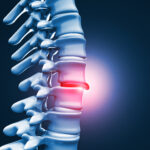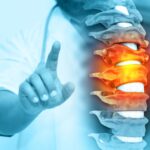
There’s More to Managing Back Pain Than Meets the Eye
Conservative treatments are usually effective for managing back pain and mid-back compression fractures, with most healing within 8 – 12 weeks. These non-surgical approaches prioritize pain management, healing, improving your ability to move, and preventing future fractures.
Treatment typically begins with a short period of rest to reduce strain on your spine. As your pain lessens, you can gradually increase your activity level, but it’s important to avoid high-impact activities, bending, twisting, and heavy lifting. Low-impact exercises like walking are encouraged once your pain is manageable.
Throughout your recovery, you can use ice packs to reduce inflammation and pain in the initial stages, and later switch to heat therapy to improve blood flow and relax your muscles. Over-the-counter pain relievers like acetaminophen and non-steroidal anti-inflammatory drugs, or NSAIDs, can also help manage pain. In some cases, stronger prescription pain medications may be necessary.
Gentle exercises play a crucial role in improving your posture and strengthening your back muscles. A physical therapist can guide you through a personalized exercise program, which may include exercises to strengthen your back extensor muscles, improve thoracic mobility, correct your posture, and engage in low-impact aerobic activities. Wearing a back brace can also provide support and limit movement to promote healing.
Your spine specialist may also recommend calcium and vitamin D supplements to support bone health. Learning proper body mechanics and lifting techniques is essential to protect your spine, and making lifestyle changes to minimize your risk of falls is also important.
Any treatment should be tailored to your individual needs and condition under the guidance of a health care professional. By combining conservative treatments, you can effectively manage pain, support healing, and regain function after a mid-back compression fracture.
Compression Fractures, Mid-Back Problems, and Managing Back Pain
Managing back pain, especially in the thoracic spine or mid-back area, can often indicate a compression fracture. These fractures happen when a vertebra in your spine weakens and collapses, which can be caused by Osteoporosis, a bad injury, or underlying conditions.
The pain is often sudden and severe, worsening with movement or standing, and localized to the fracture area. It may lessen when lying down, but it can also have a gradual onset, especially in Osteoporosis-related cases. The pain can be triggered by everyday activities, and it may be constant and dull or sharp and severe.
Usually, acute pain lasts 4 – 6 weeks and subsides within 7 – 12 weeks. Unfortunately, it can become chronic in some cases. You may have difficulty bending or twisting, or in severe cases you can lose height with multiple fractures, or even develop a hunched posture known as Kyphosis.
If left untreated, mid-back compression fractures can have lasting consequences, including:
- Chronic pain: Persistent pain that can last for months or years.
- Reduced mobility: Limited range of motion and difficulty performing daily tasks.
- Impaired pulmonary function: Breathing difficulties due to postural changes.
- Increased risk of future fractures: Substantially higher risk of additional vertebral fractures.
- Neurological complications: Rare but possible nerve damage due to spinal canal narrowing.
- Psychological and social impacts: Decreased self-esteem, social isolation, and a lower quality of life.
- Systemic health issues: Constipation, increased risk of Deep Vein Thrombosis, and falls due to immobility.
These fractures can significantly disrupt your life, limiting mobility, affecting breathing and digestion, and decreasing your overall quality of life. Early diagnosis and treatment are essential to prevent or minimize these long-term effects. Treatment options vary from conservative measures like pain management and physical therapy to minimally invasive procedures, or surgery in severe cases.
Osteoporosis-Related Risks and Other Factors
Many patients are unaware that Osteoporosis-related fractures are directly related to managing back pain. These are unlike typical fractures caused by sudden impacts, as they develop gradually due to the weakened and porous nature of your bones.
Imagine a honeycomb structure with numerous tiny cracks. It’s a good visual of how Osteoporosis can weaken your bones over the long run.
These weakened bones, especially in your spine, can gradually compress and collapse under everyday stress, leading to a hunched posture and chronic pain. While these fractures can occur in any bone, they are most prevalent in the hips, spine, and wrists.
Who’s at risk, you may ask? Although the risk of Osteoporosis increases with age, it’s not an inevitable part of aging. One in three women and one in five men over 50 will experience an Osteoporosis-related fracture.
Other risk factors include:
- Smaller body frame: Less bone mass to begin with.
- Certain medical conditions: Irritable Bowel Disease, Celiac Disease, kidney or liver disease, cancer, Multiple Myeloma, Rheumatoid Arthritis, Axial Spondyloarthritis, and Psoriatic Arthritis.
- Family history: Having a parent or sibling with Osteoporosis.
- Gastrointestinal surgery: Reduced stomach size can impair calcium absorption.
- Hormonal issues: Reduced estrogen (menopause), low testosterone, thyroid disorders, and an overactive Parathyroid or Adrenal Glands.
- Low calcium intake: A diet lacking calcium-rich foods like dairy, nuts, seeds, and leafy greens.
- Medication usage: Long-term use of corticosteroids or medications for seizures, gastric reflux, cancer, or a transplant rejection.
Understanding these risk factors can help you take preventive measures and protect your bone health.
Managing Back Pain and Your Vertebral Column
Managing back pain comes with new territory: educating yourself. The spinal column, also known as the backbone, is a series of 33 individual bones called vertebrae that extend from the skull to your Pelvis. These vertebrae are stacked on top of each other and organized into four distinct regions:
- Cervical: The neck region, containing seven vertebrae.
- Thoracic: The upper back, containing 12 vertebrae.
- Lumbar: The lower back, containing five vertebrae.
- Sacral: The base of the spine, containing five fused vertebrae.
- Below the Sacrum is the Coccyx. This is commonly known as your tailbone.
The cervical region supports your head, allowing for a wide range of motion, while the thoracic section connects to your ribs, limiting motion in this region. The lumbar area is home to your largest vertebrae, supporting most of your body’s weight.
Meanwhile, your sacral area has five vertebrae that are fused together to form your Sacrum, which connects the spine to your Pelvis. Your Coccyx, the tailbone, is formed by the fusion of five small bones.
“Although vertebrae range in size, they are the weight-bearing structures of the spinal column,” states Health Central. “Upper body weight is distributed through the spine to the Sacrum and Pelvis. The natural curves in the spine, Kyphotic and Lordotic, provide resistance and elasticity in distributing body weight and axial loads sustained during movement.”
Preventing Winter Back Injuries and Trauma Accidents
Managing back pain may seem obvious, but the first rule is to simply prevent back injuries, especially outside during winter. You can start by paying attention when there’s ice on the ground.
If you can’t get someone to shovel or clear your driveway, make sure you put down salt for ice and wear boots made for walking on ice. These usually have slip-resistant soles or metal spikes.
A common trauma accident is when elderly individuals slip on ice and fall on their back or buttocks. The good news is: unlike having a hip fracture, which needs surgical intervention, a compression fracture can be treated non-surgically.
However, as we age, changes in our bodies can increase the risk of falls and injuries, especially during winter. Here’s how to protect yourself from falls as we go into winter:
- Osteoporosis: Be extra cautious if you’re over 65, as age-related changes and hormonal shifts can contribute to Osteoporosis.
- Balance issues: Balance can be affected by various factors, including medications, inner ear problems, and past strokes. If you have concerns about your balance, consider using a walker or cane.
- Prevent lumbar strains: Lifting heavy snow can strain your lower back muscles. To avoid this, bend your knees and lift with your legs, not your back. Consider using an ergonomic shovel.
“Signs of significant injury that require urgent evaluation include any upper or lower extremity numbness, weakness, or significant pain, as well as loss of bowel or bladder function,” according to Yale Medicine. “For any of these issues, you should see a spine surgeon as soon as possible.”
While minor winter injuries may heal with rest and home care, don’t hesitate to contact your spine doctor if you have concerns or experience persistent pain.
Maxim Health
Are you searching your options for managing back pain? This is where our groundbreaking approach intersects with your needs. Maxim Health is a beacon of innovation.
Our comprehensive focus brings together luminaries in spine surgery for an unparalleled experience in care, expertise, and attention. With an extensive track record of successful and intricate procedures, Maxim is also at the forefront of non-surgical solutions. We help patients regain control of their lives, from non-invasive interventions to the latest advancements in pain relief.











